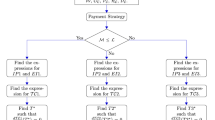Abstract
In this paper, an inventory system with a trade credit policy when payment point is not deterministic in nature is studied for deteriorating items. Under trade credit policies, the retailers have to pay at trade credit point or at a predetermined point. In practice, it is not always possible for a retailer to strictly adhere to the same payment policy every time, may be because of uncertainty of cash in hand at respective time points or for other reasons. The optimal policies are derived by taking the possibility of not making the payment in a single point every time into consideration. Two scenarios of the policies of the supplier’s conditions are considered for which retailer may respond in different ways. Three types of retailer’s response are considered in this paper. Depending on payment pattern specific to a retailer a probability distribution for the duration of payment delay is incorporated. For all these situations the expected net present value of the total cost is derived and hence optimal policies are determined. These models are illustrated through numerical examples. The sensitivity analysis is carried out with respect to various parameters. The total costs which are optimally obtained give the actual expected cost and hence minimize budgetary variance.
Similar content being viewed by others
References
Goyal, S.K.: EOQ under conditions of permissible delay in payments. J. Oper. Res. Soc. 36, 335–338 (1985)
Aggarwal, S.P., Jaggi, C.K.: Ordering policies of deteriorating items under permissible delay in payments. J. Oper. Res. Soc. 46, 658–662 (1995)
Chung, K.H.: Inventory control and trade credit revisited. J. Oper. Res. Soc. 40, 495–498 (1989)
Arcelus, F.J., Shah, N.H., Srinivasan, G.: Retailer’s response to special sales: price discount vs. trade credit. OMEGA 29, 417–428 (2001)
Chung, K.J., Liao, J.J.: The optimal ordering policy in a DCF analysis for deteriorating items when trade credit depends on the order quantity. Int. J. Prod. Econ. 100, 116–130 (2006)
Hwang, H., Shinn, S.W.: Retailer’s pricing and lot sizing policy for exponentially deteriorating products under the condition of permissible delay in payments. Comput. Ind. Eng. 24(6), 539–547 (2003)
Goyal, S.K., Giri, B.C.: Recent trends in modeling of deteriorating inventory. Eur. J. Oper. Res. 134(1), 1–16 (2001)
Jaggi, C.K., Aggarwal, K.K., Verma, P.: Inventory and pricing strategies for deteriorating items with limited capacity and time-proportional backlogging rate. Int. J. Oper. Res. 8(3), 331–354 (2010)
Tripathi, R.P., Misra, S.S.: Credit financing in economic ordering policies of non- deteriorating items with time dependent demand rate. Int. Rev. Bus. Finance 2, 47–55 (2010)
Jaggi, C., Aggarwal, S.: Credit financing in economic ordering policies deteriorating items. Int. J. Prod. Econ. 34, 151–155 (1994)
Roy, A.: An inventory model for deteriorating items with price dependent demand and time varying holding cost. Adv. Model. Optimization 10, 25–37 (2008)
Soni, H., Shah, N.H., Jaggi, C.K.: Inventory models and trade credit: a review. Control. Cybern. 39(3), 867–882 (2010)
Chaudhuri, K.S., Roy, T.: An inventory model for a deteriorating item with price-dependent demand and special sale. Int. J. Oper. Res. 2(2), 173–187 (2007)
Chang, C.T., Wu, S.J., Chen, L.C.: Optimal payment time with deteriorating items under inflation and permissible delay in payments. Int. J. Syst. Sci. 40(10), 985–993 (2009)
Jamal, A.M.M., Sarker, B.R., Wang, S.: An ordering policy for deteriorating items with allowable shortages and permissible delay in payment. J. Oper. Res. Soc. 48, 826–833 (1997)
Liao, J.-J., Haung, K.-N.: An inventory model for deteriorating items with two levels of trade credit taking account of time discounting. J. Oper. Res. Soc. 30, 35–50 (2008)
Liao, H.C., Tsai, C.H., Su, C.T.: An inventory model with deteriorating items under inflation when a delay in payment is permissible. Int. J. Prod. Econ. 63, 207–214 (2000)
Mandal, B.N., Phaujdar, S.: An inventory model for deteriorating items and stock-dependent consumption rate. J. Oper. Res. Soc. 40(5), 483–488 (1989)
Ouyang, L.Y., Teng, J.T., Goyal, S.K., Yang, C.T.: An economic order quantity model for deteriorating items with partially permissible delay in payments linked to order quantity. Eur. J. Oper. Res. 194(2), 418–431 (2009)
Roy, T., Chaudhuri, K.S.: A production-inventory model under stock dependent demand, Weibull distribution deterioration and shortage. Int. Trans. Oper. Res. 16(3), 325–346 (2009)
Tsao, Y.C., Sheen, G.J.: Joint pricing and replenishment decisions for deteriorating items with lot-size and time-dependent purchasing cost under credit period. Int. J. Syst. Sci. 38(7), 549–561 (2007)
Mohini, K., Pakkala, T.P.M.: Inventory model under trade credit when time of payment is uncertain. Int. J. Math. Arch. 3(7), 2669–2679 (2012)
Author information
Authors and Affiliations
Corresponding author
Appendix A
Appendix A
Rights and permissions
About this article
Cite this article
Kumari, M., Pakkala, T.P.M. Inventory policy for deteriorating items under trade credit when time of payment is uncertain. OPSEARCH 53, 178–196 (2016). https://doi.org/10.1007/s12597-015-0223-8
Accepted:
Published:
Issue Date:
DOI: https://doi.org/10.1007/s12597-015-0223-8




